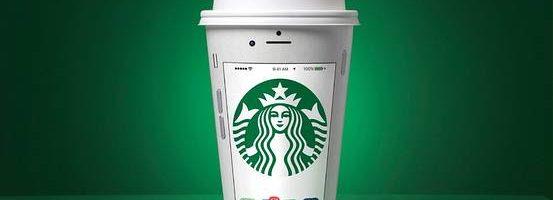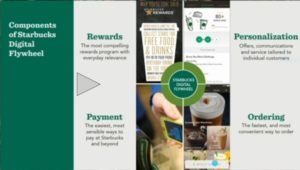Starbucks: a tech company or your neighborhood coffee shop?

Starbucks is using its digital platform to enhance your coffee buying experience while gaining revenue and customer loyalty.
As retail has declined in the US, stores are finding new ways to connect with shoppers and create special or convenient experiences. Starbucks has achieved this by building what they call their Digital Flywheel, focused on four pillars: rewards, personalization, payment, and ordering.
In Q3 2017, 9% of Starbucks orders were placed in advance and 30% were paid via the company’s mobile app. These astonishing numbers show that Starbucks is changing consumers payment behavior to an extent that no tech company has been able to accomplish. For comparison, only 5.5% of Apple users use Apple Pay given the chance. The company announced that it will now allow non-rewards members to use the app and is redesigning its stores to better suit the increased order ahead traffic as they expect this will continue to grow.
Starbucks has identified an opportunity to drive customer loyalty and increased spending through their mobile app. Currently, 18% of Starbucks’ 75 million customers are members of their mobile loyalty program, but they represent 36% of sales. Furthermore, in Q3 2007, spending per member increased 8% which is double the rate of the company’s same-store sales. By personalizing the app and pushing new products to upsell customers to more expensive or additional items, Starbucks has drawn more value from their customers.
Additionally, Starbucks has leaned into digital partnership to spark growth. In China, their partnership with Tencent resulted in 2 million gift transactions in 6 months. They plan to leverage their close relationships with customers and digital partnerships to achieve growth in the future.
On a recent investors call, Starbucks’ CEO Kevin Johnson, spoke about the “massive disruption” plaguing the retail sector. He says he believes that the “winners” will be companies that integrate digital with their in-store experience. And this is exactly what Starbucks is trying to do with their mobile app and digital partnerships. This is particularly important for his company who has a massive physical foot print of ~27,000 stores worldwide with plans to grow to37,000 by 2021. For every Starbucks store, there are on average, 3.6 stores within a 1 mile radius.
Looking forward, Starbucks wants to grow membership and increase personalization through customized push alerts triggered by things like weather. Furthermore, they are integrating the app data into the store experience, so baristas will know when it’s someone’s birthday or other information about the customer so they can give them special treatment. As their database of customers grow and they learn more about spending habits, their mobile loyalty program will drive great growth at an increased rate.
When it comes to restaurant chains creating a digital platform, Starbucks is winning. They’ve found a way to meaningfully connect with consumers in a manner that changes consumers’ paying and ordering habits. Dunkin Donuts, for example, has tried a similar approach with less success. In Q3 2017, 11% of sales came from their loyalty program members and mobile orders represented only 3% of total sales. We’ll have to see what the next digital innovation will be for these companies, but at this moment, Starbucks is definitely leading in the race.
Sources:
https://www.barrons.com/articles/starbucks-teaches-silicon-valley-a-lesson-in-tech-1503115292
https://www.marketingweek.com/2017/07/28/starbucks-digital-partnerships/
https://diginomica.com/2017/10/31/dunkin-donuts-digital-mostly-donuts/





Starbucks digital transformation has been successful indeed. Looking at the company’s performance overall in 2017, however, digitalization should accelerate further across the chain to capture customer value for two reasons. 1) Growing into a coffee behemoth to a great pleasure of the Street, Starbucks has lost its neighborhood feel and has gained corporate reputation, which leads to struggle of acquiring both aspiring baristas and the clientele. 2) Younger generation of millennials is switching to hipster one-off Aussie coffee shops with piccolo latte and bearded employees. Hence, further digitalization is even more needed to ensure that Starbucks attracts mobile first millennials, combined with review of the whole customer experience inside the coffee shops, which might create tension with investors’ expectations.
Great post, Kat! It’s interesting to see retail companies such as Starbucks mitigate the risk of declining in-store retail sales through the use of digital innovation. Another huge value opportunity for Starbucks will be in the information that it can gather from its customers that use the mobile app options. Starbucks will be able to further upsell customers through sending push alerts of advertisements for coffee and food items that they may enjoy based on their previous search information and interests. It’s exciting (but also frightening!) to see retailers gather so much information from their customers and use it to influence customer buying decisions.
Thank you for sharing Kat. It is very interesting to see a retail player winning the era of massive uncertainty within a retail industry. Everyone seems to be talking about an omnichannel strategy and/or offline to online strategy but few actually found the right recipe. I think Kevin Johnson did very well in adjusting the core value of Starbucks with the digital trend. The strategy is still center around the company core assets which is the store network. The digital part of it allows the company to improve customer in-store experience e.g., order online in advance could save you time. Furthermore, he leverages technology to improve the loyalty program. Overall, I think Starbucks is doing remarkably well. It seems like for now the company has found the recipe to stay even more competitive with the support of technology.
It’s crazy to think that in many ways Starbucks is evolving into a payments company masquerading as a coffee shop instead of the other way around. I am a huge consumer of starbucks and I think there are many lessons to be gleaned from their digital transformation. However, like Iryna I worry about them striking the right balance between tech forward and invasive. For example, I’m not sure I want starbucks sending me push notifications to go buy coffee. That’s a nuisance and just adding to the noise of increasingly useless information that we all have pushed to our phone every day. I just hope that the company can push its tech agenda without losing its soul and it’s goal of being the world’s :third place.”
Nice post! I really liked Starbuck’s clear and focused strategy in the midst of decreasing physical retail stores sales. They appear to have honed in on a few key things that their consumers really care about. At the same time, looking into the future I’m not entirely convinced pushing small features like birthday notifications and weather alerts will keep Startbucks safely away from the e-commerce storm.
I really enjoyed reading this, as a coffee lover and fan of Starbucks’ app. I thought the part about having customized store experiences, such as baristas being informed of customers’ birthdays, was really interesting. However, I’m also wondering how such actions would be enforced? While this experience is certainly good for the customer, the employee may not be getting any additional benefit from doing so.
I agree with the article that Starbucks is trying to position itself as a technology company in order not to be disrupted. The coffee shop business is getting more and more crowded with both national chain brands, local chain brands and numerous independent prestige coffee shops. Under such a fierce competition, Starbucks really needs to leverage technology to improve the service of the brand, and also keep the brand image energetic, young and trendy.
I definitely agree that Starbucks has positioned itself well among its competitors. I wonder if increased personalization and new ways to engage members will create more operational complexities and require more baristas on the payroll to provide this better experience. Can this be offset by pushing more orders online prior to arrival to free up barista time to engage with customers vs taking orders?
I am a native Seattleite and a Starbucks loyalist, so I am biased towards thinking that they are eternal winners, which you are artfully shown in your post. I would be curious to see if Starbucks can leverage their digital capabilities to start to recreate the neighborhood coffee shop community of their roots. They could use their platform to create digital new digital communities around coffee, bringing a new layer into the coffee drinking experience.
It’s fascinating how Starbucks is able to use its mobile application to more tightly integrate into its customer’s lives. My concern is that this effort might not perfectly fit into Starbuck’s original position as “the third place.” By bringing more of the experience out of the store, it makes the time in-store a transactional one that could be usurped by a competitor that somehow figures out the mobile experience even better. This makes your analysis of how they can use this information not to just make customer interactions more efficient, but also more rewarding even more important.
Nice post, I actually think Starbucks is one of the few Amazon proof retailers out there. It is interesting to see how they also leverage digital for their advantage. Many other loser retailers should learn lessons from Starbucks positive experience with millennials and the digital age. I actually use Starbucks app and find it very useful. It will definitely increase customer loyalty and traffic.